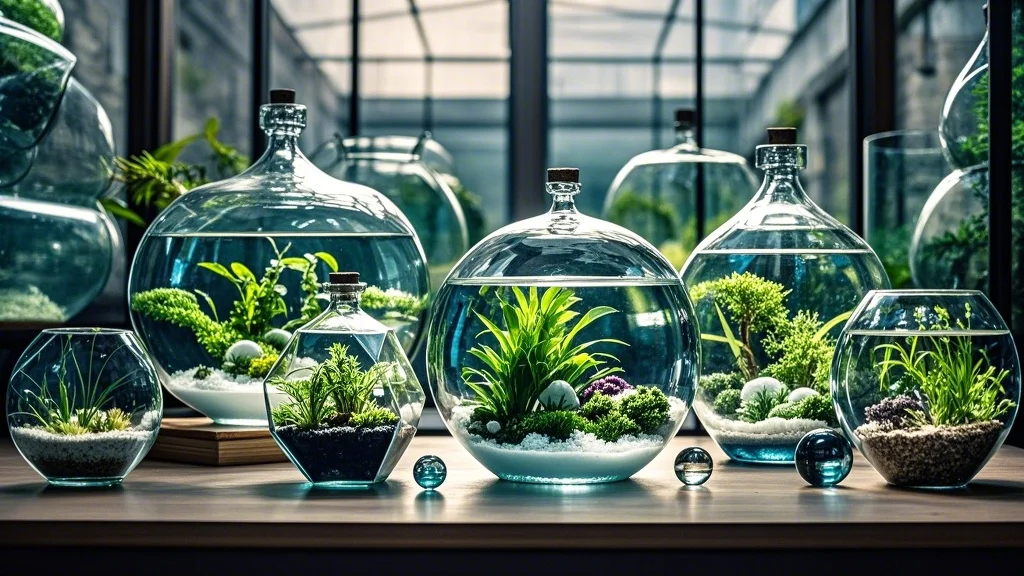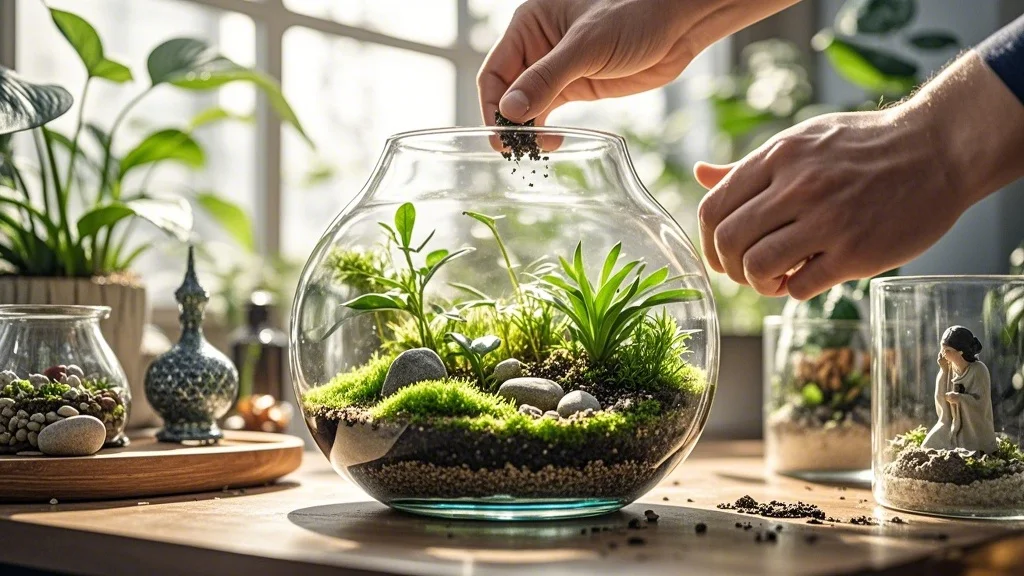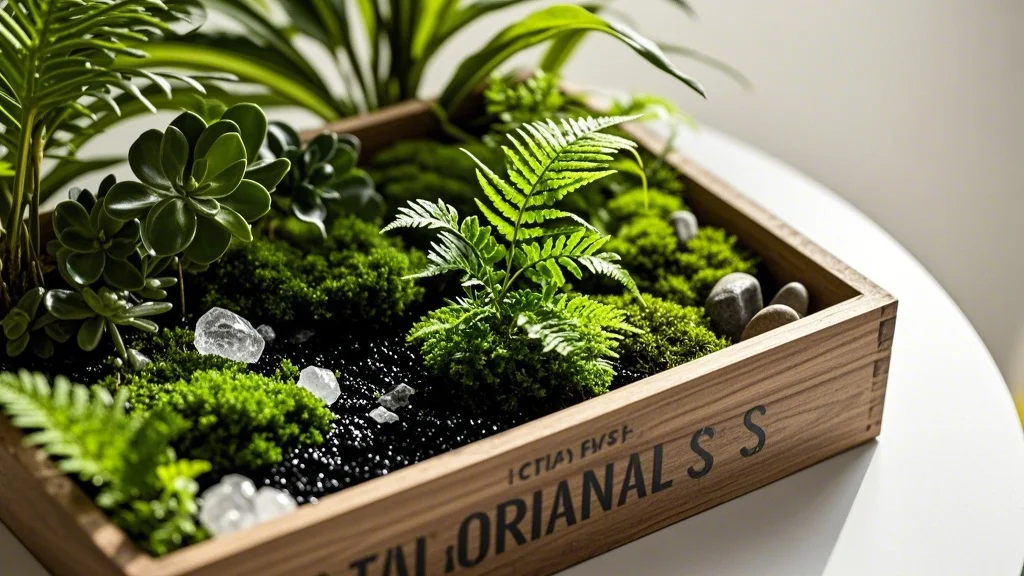Large terrariums are more than just plant containers; they’re living works of art that can transform a room. These enclosed ecosystems serve as captivating focal points, bringing a slice of nature indoors on a grand scale. In this guide, we’ll explore how to create and maintain impressive large-scale terrariums that double as statement pieces for your home or office.
Contents
Choosing the Right Container

The foundation of any large terrarium is the container itself. When selecting a vessel for your statement piece, consider the following:
Size and Shape
- Aim for containers at least 2 feet in diameter or height
- Popular shapes include globes, cylinders, and geometric designs
- Ensure the opening is wide enough for easy planting and maintenance
Material
- Glass is the most common and visually appealing option
- Look for thick, high-quality glass to support the weight of soil and plants
- Consider acrylic for a lighter, shatter-resistant alternative
Style
- Modern: Clean lines and minimalist designs
- Vintage: Repurposed fish tanks or antique glass cloches
- Artistic: Custom-blown glass or uniquely shaped vessels
Planning Your Terrarium Landscape
Before planting, envision the overall design of your terrarium. Consider these elements:
Focal Points
- Create a visual hierarchy with varying plant heights
- Incorporate eye-catching elements like colorful stones or driftwood
- Use the rule of thirds to place key features off-center for visual interest
Layering
- Start with a drainage layer of pebbles or activated charcoal
- Add a layer of sphagnum moss to separate drainage from soil
- Use high-quality, well-draining potting mix for the planting medium
Microclimates
- Create different zones within the terrarium
- Vary soil depth and composition for diverse plant needs
- Consider incorporating small hills or valleys for visual depth
Selecting Plants for Large Terrariums
Choosing the right plants is crucial for a thriving, visually striking terrarium. Consider these factors:
Size and Growth Habits
- Select plants that won’t quickly outgrow the space
- Mix plants with different growth habits for visual variety
- Include slow-growing species to maintain the design long-term
Light Requirements
- Choose plants with similar light needs
- Consider the placement of your terrarium in your home
- Opt for low to medium light plants for most indoor locations
Humidity Tolerance
- Select plants that thrive in high-humidity environments
- Include species that naturally grow in tropical understories
- Avoid plants prone to rot or fungal issues in moist conditions
Recommended Plants for Large Terrariums
- Ficus pumila (Creeping Fig)
- Peperomia varieties
- Cryptanthus (Earth Stars)
- Neoregelia bromeliads
- Selaginella (Club Moss)
- Pilea species
- Miniature orchids
- Fittonia (Nerve Plant)
- Tillandsia (Air Plants)
- Small ferns (e.g., Button Fern, Bird’s Nest Fern)
Creating Your Large Terrarium

Follow these steps to assemble your statement piece terrarium:
- Clean the container thoroughly with a mild soap solution and rinse well.
- Add a 1-2 inch layer of pebbles or activated charcoal for drainage.
- Place a layer of sphagnum moss over the drainage material.
- Add 3-4 inches of well-draining potting mix, creating contours as desired.
- Plan the placement of your plants, starting with the largest specimens.
- Carefully remove plants from their pots and loosen the root balls.
- Create holes in the soil and plant each specimen, firming the soil around the roots.
- Add decorative elements like rocks, wood, or miniature figurines.
- Mist the plants and soil lightly to settle everything in place.
- Clean any soil or water droplets from the glass for a polished look.
Maintaining Your Large Terrarium
Proper maintenance is key to keeping your statement piece looking its best:
Watering
- Water sparingly, as terrariums retain moisture
- Allow the top inch of soil to dry between waterings
- Use a spray bottle or small watering can with a narrow spout
Light
- Place in bright, indirect light for most plant combinations
- Rotate the terrarium periodically for even growth
- Consider supplemental grow lights for low-light areas
Pruning and Cleaning
- Trim plants regularly to maintain shape and prevent overcrowding
- Remove any dead or yellowing leaves promptly
- Clean the glass inside and out to maintain visibility
Fertilizing
- Feed plants sparingly, using a diluted liquid fertilizer
- Apply fertilizer no more than once every 2-3 months during growing season
- Avoid over-fertilizing, which can lead to excessive growth
Ventilation
- Open the terrarium periodically to allow fresh air circulation
- Remove excess condensation if it obstructs the view
- Monitor for signs of mold or fungal growth
Troubleshooting Common Issues
Even with careful maintenance, large terrariums can face challenges:
Algae Growth
- Reduce watering and increase air circulation
- Clean affected areas with a diluted hydrogen peroxide solution
- Consider adding a layer of decorative sand or pebbles on top of the soil
Pest Infestations
- Isolate the terrarium from other plants
- Remove affected plants if possible
- Treat with neem oil or insecticidal soap, being careful not to oversaturate
Leggy or Stretched Plants
- Increase light exposure gradually
- Prune affected plants to encourage bushier growth
- Consider replacing with more suitable low-light species
Mold or Fungus
- Improve air circulation by opening the terrarium more frequently
- Remove affected plant material and top layer of soil
- Apply a fungicide formulated for terrariums if the problem persists
Creative Ideas for Statement Piece Terrariums
Take your large terrarium to the next level with these creative concepts:
Themed Landscapes
- Create a miniature rainforest with multiple layers of vegetation
- Design a desert oasis with succulents and colorful sand
- Craft a moss-covered fairy garden with tiny accessories
Integrated Lighting
- Install LED strip lights around the base for a subtle glow
- Use color-changing bulbs to create different moods
- Incorporate fiber optic strands for a magical starry effect
Living Art
- Mount your terrarium on a wall as a 3D plant picture
- Create a terrarium coffee table with a glass top
- Design a hanging terrarium mobile with multiple smaller containers
Seasonal Displays
- Change out decorative elements to reflect different seasons or holidays
- Add faux snow or autumn leaves for temporary themed displays
- Incorporate air plants that can be easily swapped for variety
Conclusion
Large terrariums offer a unique opportunity to bring a piece of nature indoors on a grand scale. By carefully selecting your container, plants, and design elements, you can create a stunning statement piece that serves as a living focal point in any room. With proper care and maintenance, your large terrarium will continue to evolve and captivate, providing a lush, miniature ecosystem for years to come. Whether you’re an experienced plant enthusiast or a beginner looking to make a bold botanical statement, a large terrarium is an excellent way to showcase your creativity and bring the beauty of nature into your living space.







